🏆 Indo-Korea Friendship Day Competition Winners
🎨 Poster Making Competition
Handmade Posters
🏅 Winner 1
SNEHALATA MEGHWAL
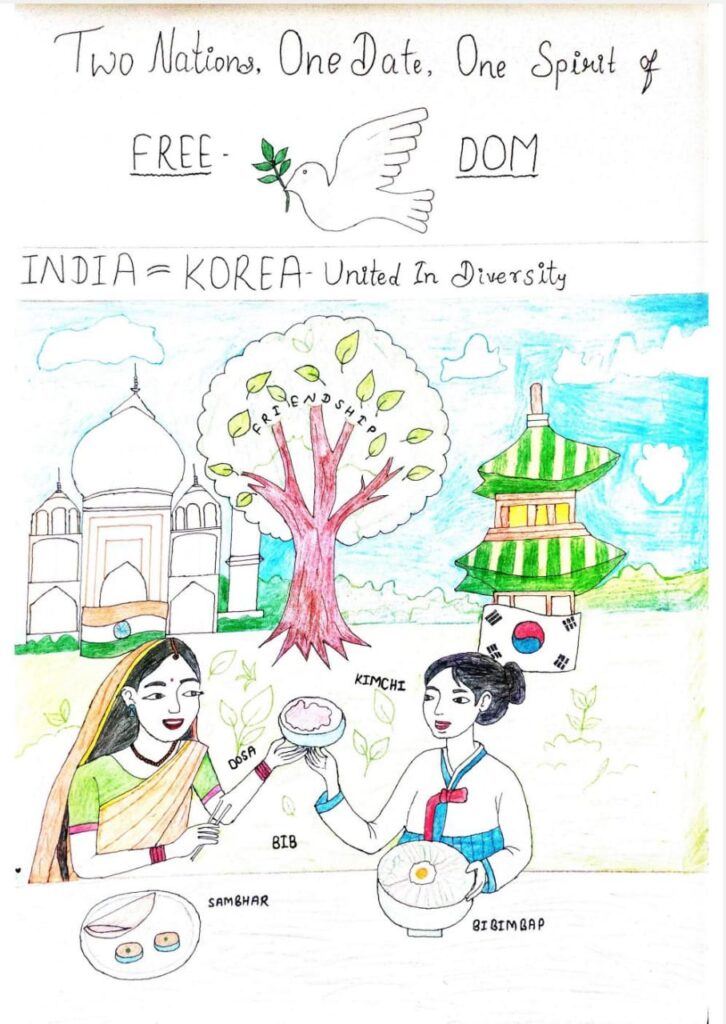
🏅 Winner 2
SWASTI SHARMA
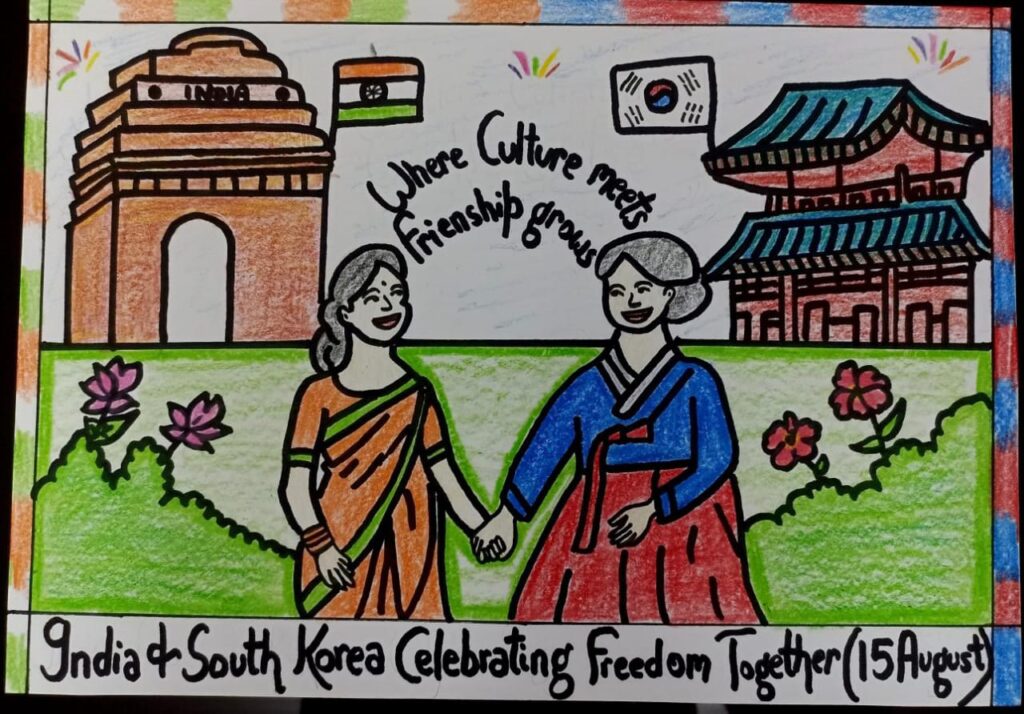
Digital Posters
🏅 Winner 1
KHUSHI PARWEEN

🏅 Winner 2
SHIVRAJ PATEL
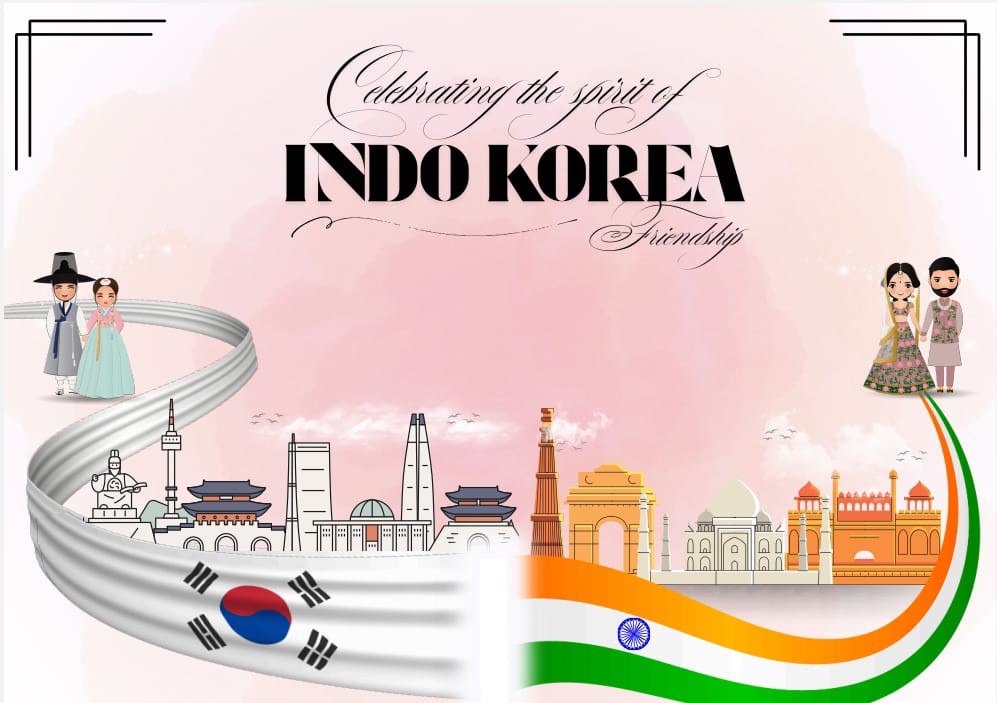
🏅 Winner 3
ALISHA NAAZ
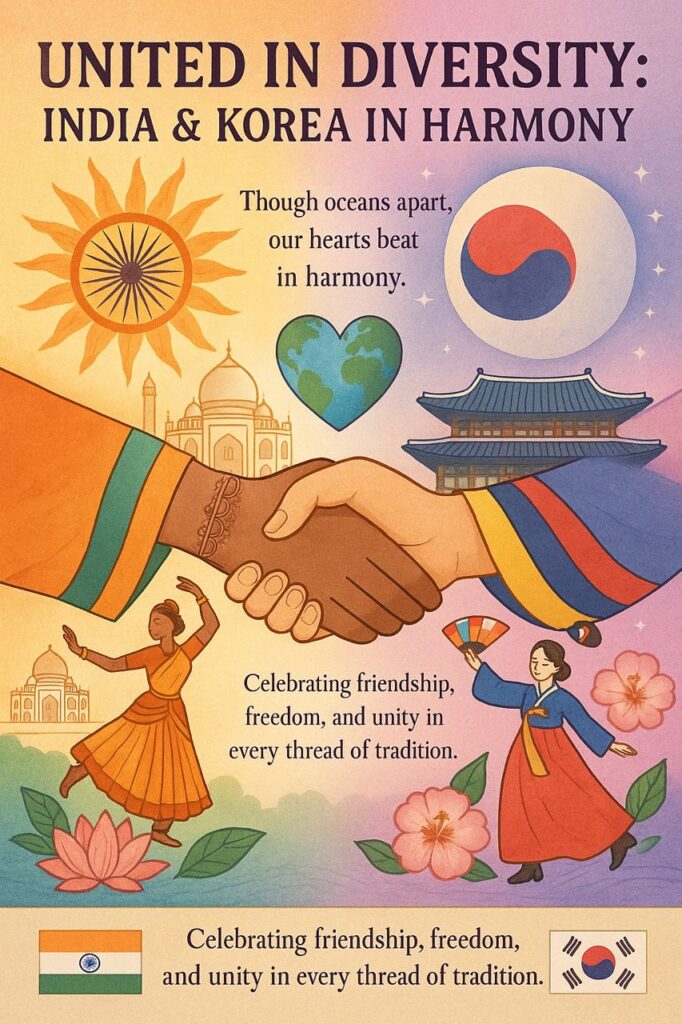
🏅 Winner 4
PRIYANSHI VAISHNAV
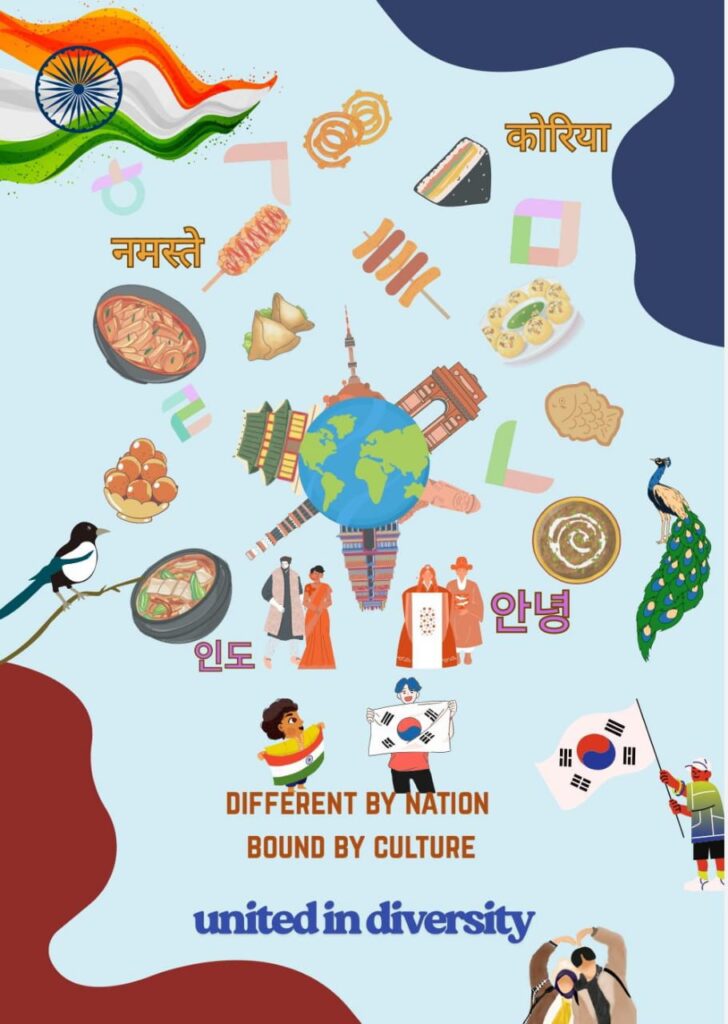
✍️ Essay Writing Competition
🏅 Winner 1
ANGEL SAINI
FREEDOM THROUGH OUR EYES: INDIA and KOREA THEN AND NOW (A reflection on the Journey of Two Nations Towards
Freedom)
INTRODUCTION – The meaning of Freedom
Freedom for me, is the quiet comfort of knowing my choices are my own, and the l loud joy of celebrating my culture without fear. It is the power to speak, to dream, and to live with dignity. Both India and Korea understand this feeling deeply – because neither was born free. Our histories marked with pain, resistance, and sacrifice. But they are also filled with courage and unity. Looking at India and Korea, then and now I see two nations that fought for the light, found it, and now share it with the world. Then A Tale of Two Struggles India’s fight for freedom was long and exhausting. Under British colonial rule for nearly 200 years, we faced economic exploitation, cultural suppression, and loss of political voice. Yet, the spirit of independence never died. Leaders like Netaji Subash Chandra Bose inspired millions through his call “Give me blood, and I will give you freedom. His leadership of the INDIAN NATIONAL ARMY (INA) mobilized soldiers and civilians alike, aiming to liberate from British colonial rule through armed resistance. On 15 th August 1947, the tricolour flag rose above a free India. Korea’s story, though different, feels familiar. From 1910 to 1945, Japanese occupation tried to erase Korean identity banning the language, changing names, and every aspect of life. The March 1 st Movement in 1919 was a brave cry for independence, met with harsh punishment but remembered as a turning point. Liberation came on 15th August 1945, a date Korea calls Gwangbokjeol (광복절) “the day the light returned.
🏅 Winner 2
RIYA HALDER
FREEDOM THROUGH OUR EYES : INDIA AND SOUTH KOREA THEN AND NOW
South Korea and India are two countries vastly apart and full of distinctive cultures and they both share a parallel in their adversity. The two countries suffered under colonialism. They emerged from this oppression to become major players in international economics and culture. Both of their paths in history present impressive parallel struggles over independence, the journey toward democracy and the challenges of the contemporary world. What is engaging about their histories is the way they balanced the fine line between maintaining their centuries-old traditions and adopting modernity. This rhythm enabled them to create unique identities in the world. Korea was under the repressive control of Japanese occupation between 1910 and 1945. India was under British rule for almost two centuries, from 1757 to 1947. Throughout these times, colonial powers intentionally suppressed native cultures. They used natural resources for their own interests. Foreign systems of administration were imposed, destroying the social network of both countries. The Korean language, Hangul, was prohibited in South Korea and many people were forcibly taken to mainland Japan. Likewise, in India, the British enforced their own language “English” and compelled Indians to accept Western culture.
🏅 Winner 3
SHREE VAISHNAVI CHILLARA
Two Nations, One Spirit – My India, My Korea
When we think of freedom, the first image that comes to mind is often political independence— the moment a country breaks free from the grip of another power. But freedom, for both India and Korea, is not just about hoisting a flag or signing a declaration. It is about the resilience of people who refused to let their spirit, culture, and identity be erased, no matter how heavy the chains of occupation were. Growing up in India, I was told stories of how my grandparents’ generation lived in a time when speaking their own language freely or making choices for themselves was a political act. Then, as I learned more about Korea, first through history books and later through my love for Korean culture, I realized just how deeply our two nations share this history of struggle. Though thousands of kilometres apart, both countries have faced colonial rule that tried to reshape them from the inside out. India fought nearly 200 years under British rule, while Korea endured 35 years under Japanese occupation. In both cases, the battle was not just for land, but for the soul of the people. One of the most fascinating things about this shared history is that it also has personal, human connections that go beyond politics. Centuries ago, there was the story of Suriratna, an Indian princess from Ayodhya who travelled all the way to Korea and married King Kim Suro of the Gaya kingdom. Even though this happened in centuries back, it is a symbol of how India and Korea have been tied together through culture, friendship, and human connection for longer. We sometimes realize, “Why does this feel so close to home?” The way families gathered, the respect for elders, the big festivals — it wasn’t just familiar, it was almost identical to the way we live in India.
🏅 Winner 4
SHREYA PANDEY
Freedom is more than the absence of chains; it is the power to shape an identity, culture, and destiny. The 15 August Indian Independence Day and the liberation day on the same date in Korea are keen reminders of how, though separated by oceans, these two countries share a very deep historical connection. Both nations had suffered under foreign rule for decades, trying to hold onto their identities, and hobnobbing as vibrant democracies. In a way, I wish to look at the parallels between the Indian and Korean struggles of the past and their current shared path as we ponder what freedom really means for us today. The two nations were colonially oppressed in the early 20th century- British ruled India and Japanese ruled Korea. The British drained India of its resources and tried to diminish cultural pride; however, the concurrence of Indian leaders like Mahatma Gandhi, Jawaharlal Nehru, and Subhas Chandra Bose of mobilizing the masses through non-violent resistance-interacted with the spirit of sacrifice during the Salt March, Quit India Movement, and innumerable incidents of common citizens-from which India finally saw itself free in 1947. Korea went through intense Japanese policies from 1910-1945 that sought to annihilate the language, culture, and history. The March 1st Movement, in 1919, was the watershed moment when a large number of Koreans took to the streets to demand independence. Brave patriots like Yu Gwan-sun and Kim Gu stood symbols of courage. Even though the Japanese forces put down these movements brutally, the resistance spirit was never smothered. Finally, in 1945, at the ending of World War II, Korea again saw its sovereignty, but the whole episode ended soon in the tragic division into the North and the South.
🏅 Winner 5
KARINA KUMARI
The histories of India and Korea resonate across the globe, like melodies echoing through time. Despite their geographical separation, both nations shared a common aspiration: the
attainment of freedom. This essay delves into their respective paths to independence, examining their experiences under foreign rule, their efforts to preserve cultural identities, and their unwavering progress. It explores the struggles each country endured in their quest for liberation, while simultaneously safeguarding their unique cultural legacies. India’s journey to independence was a protracted struggle against British colonial rule, primarily employing non-violent methods. The Indian National Congress, led by figures like Mahatma Gandhi, mobilized millions through peaceful protests, civil disobedience, and negotiations. This movement, fueled by a deep sense of national identity and a desire for self-governance, faced significant challenges, including brutal repression and political
maneuvering by the British. However, the unwavering commitment of the Indian people and the moral high ground of non-violence ultimately pressured the British to grant
independence in 1947. This victory was hard-won, accompanied by the tragic partition of India and Pakistan, resulting in widespread displacement and violence. Korea, on the other hand, grappled with Japanese occupation, a period marked by harsh suppression of Korean culture and forced assimilation. The March 1st Movement of 1919, a non-violent demonstration for independence, was brutally suppressed, but it ignited a spirit of resistance. After World War II, Korea was divided, leading to the devastating Korean War (1950-1953), which pitted the North and South against each other, backed by different global powers. The war caused immense destruction and loss of life, leaving a deep scar on the Korean peninsula. Despite these hardships, the Korean people persevered, rebuilding their nation and striving for reunification.
🎭 Face Art Competition
🌟 Winner Spotlight
SNEHA CHATTOPAADHYAAY
